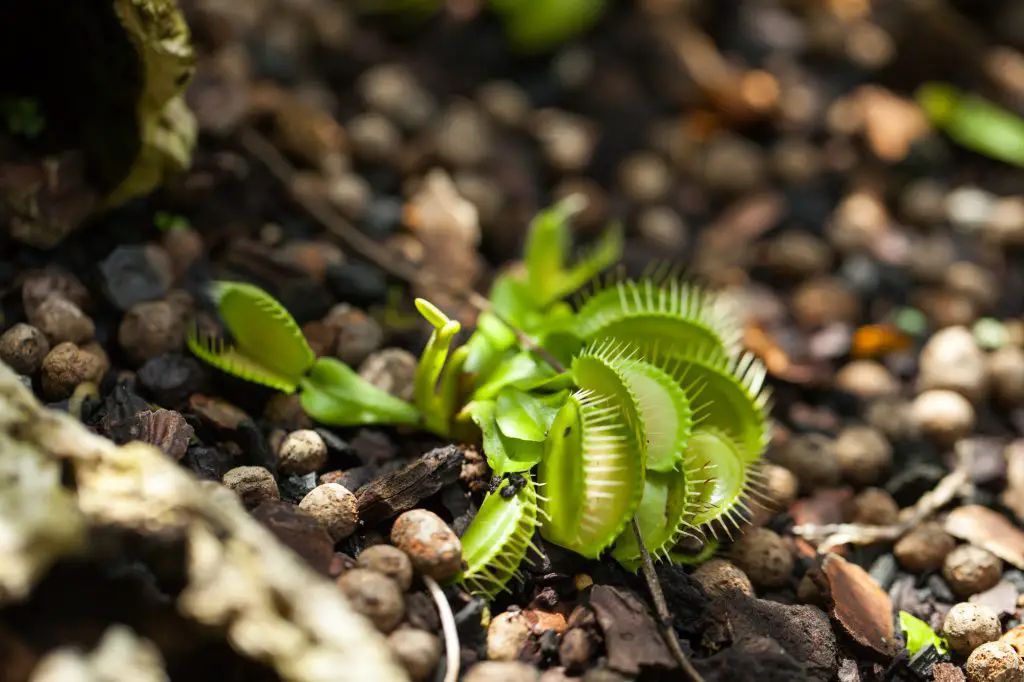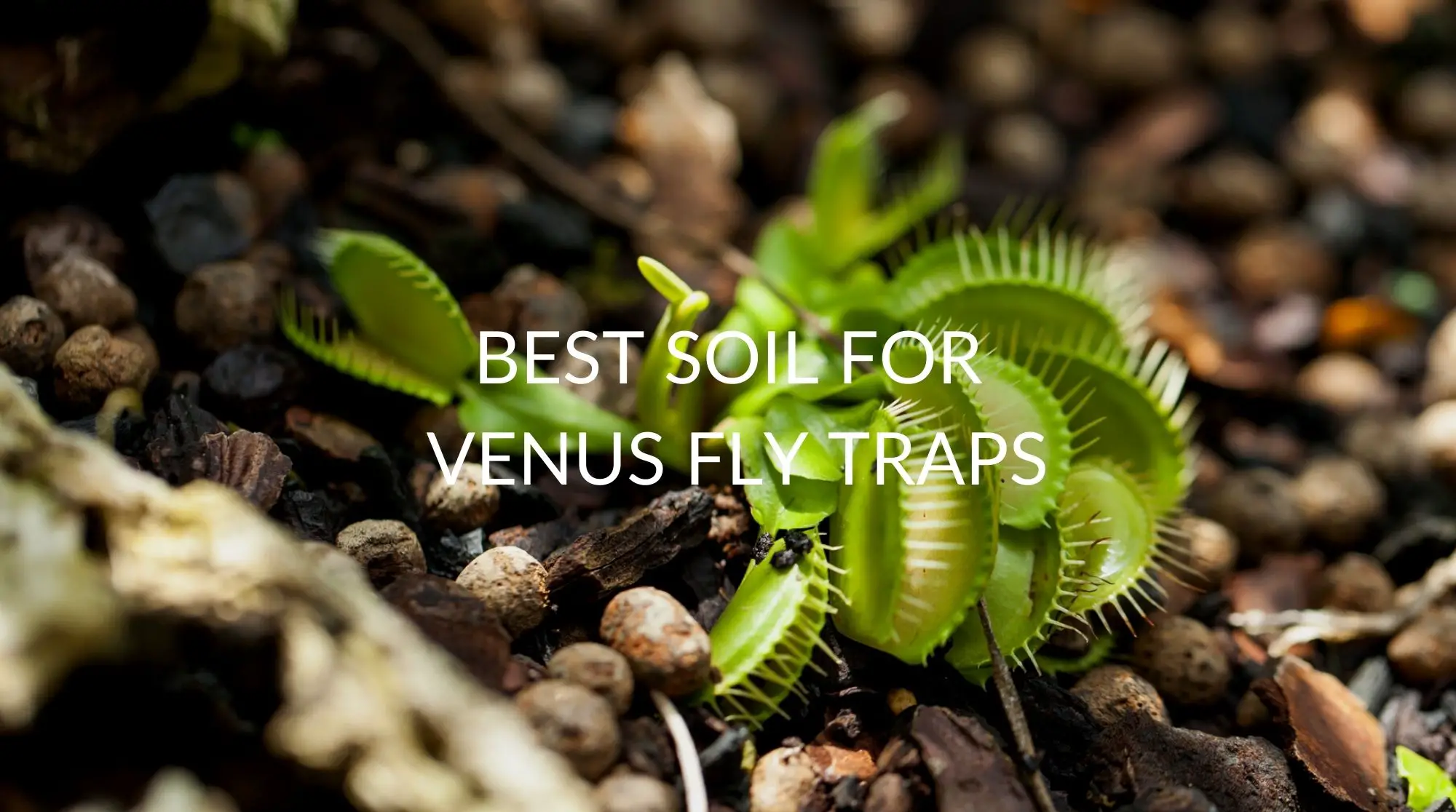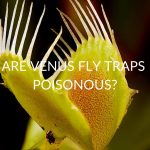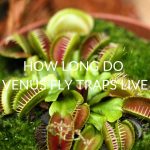Venus flytraps are unable to assimilate soil minerals or nutrients. As a result, you must use mineral-free, nutrient-free components. Some highly recommended soil mixes to use for your Venus flytrap include Perfect Plants Carnivorous Plant Soil, Organic Earth Carnivorous Plant Soil Mix, Bliss Gardens Premium Carnivorous Potting Mix, Jessi Mae Carnivorous Plant Soil, and Birch Seed Soil Carnivorous Plant Soil.
Continue reading to discover more about the best soil for your Venus flytrap, as well as how to prepare the soil, potting steps, frequently asked questions, and more.
Top 5 Soil Mixes for Venus Flytrap
Perfect Plants Carnivorous Plant Soil
Perfect Plants soil combination for Venus flytraps lives true to its name by being an ideal mix that will keep your flytraps happy. This organic mixture of peat moss, perlite, and sand is excellent for Venus flytraps.
The pH level has been adjusted to meet the demands of this plant. This bag holds 4 quarts of potting mix, but it may be resealed to keep the contents fresh for future use.
Organic Earth Carnivorous Plant Soil Mix
This Organic Earth soil for Venus flytraps is considered the best soil mixture for healthy and happy plants. It’s a 50-50 mix of organic sphagnum peat moss and perlite that keeps your flytrap’s roots wet without drowning it.
This potting mix comes in 1 quart or 2-quart bags. Reviewers were delighted with this product while using it with their Venus flytraps, stating that it was of excellent quality and helped their flytraps stay healthy.
Bliss Gardens Premium Carnivorous Potting Mix
Bliss Gardens’ soil mix is light and airy, making it ideal for Venus flytraps. This organic blend of peat moss, vermiculite, and perlite keeps your plant’s roots appropriately moistened without allowing excess moisture to accumulate. This soil mix comes in a 4-quart bag, so the more, the merrier with this potting mix.
Those who purchased Bliss Gardens’ soil mix were ecstatic about the soil’s quality and how it improved the health of their Venus flytraps. They were especially pleased with the lightweight nature of the product, which left their roots adequately aerated.

Birch Seed Soil Carnivorous Plant Soil
Birch Seed Soils truly provides wonderful soil for Venus flytraps. With an acidic pH range of 3.5 to 4.5, this soil mix is suitable for acid-loving Venus flytraps. For moisture retention and drainage, the soil is a 60/40 combination of sphagnum peat moss and perlite.
This product has received excellent reviews from customers who say it was ideal for their Venus flytrap and helped it keep the proper quantity of moisture to grow.
Jessi Mae Carnivorous Plant Soil
Jessi Mae’s chemical-free and completely organic potting mix is ideal for your Venus flytraps. This mixture of peat moss, perlite, and vermiculite is perfect for the root growth of your flytraps. This soil from the United States is available in various sizes, making it ideal for gardeners with many plants.
What Kind of Soil Mix is Best for Venus Flytrap?
For Venus Fly Traps, any ordinary gardening soil will not suffice. Venus Fly Traps grow best on nutrient-deficient mossy soil. If you wish to grow them indoors, combine silica sand, perlite, and peat moss in a soil mixture. Your flytrap needs nutrient-free soil with sufficient drainage and aeration to thrive. One part peat moss and one part perlite is a standard soil composition for a Venus flytrap.
Some recipes for generating a carnivorous plant soil mix for your Venus flytrap include a 4:1 or 2:1 ratio of peat moss and perlite, a 4:1 or 2:1 ratio of peat moss and silica sand, a 4:1 or 2:1 ratio of sphagnum moss and perlite, and a 4:1 or 2:1 ratio of sphagnum moss and silica sand.
When preparing the soil for your plant, the most crucial thing to remember is to use only pure elements. Miracle Grow and any other enriched potting material should be avoided. Instead, choose 100% pure moss devoid of extra nutrients from fertilizers. It may seem counterintuitive, but nutrient-free soil is essential for your Venus flytrap.
For your Venus flytrap, you must alternatively use pure sphagnum moss or peat moss in the form of a draining agent.
Venus flytrap soil must be kept wet at all times. The plant is susceptible to root rot if the earth is compacted and does not drain correctly. And root rot might be fatal to the plant. Use pure moss media only provided you are cautious not to overwater the plant since overwatering may result in plant decay.
What pH Range is Best for Venus Flytrap?
The soil preference of Venus flytraps is acidic, with a pH range of 4.9 to 5.3. While Venus flytrap soil is generally acidic enough, you may reduce the pH by adding soil sulfur if you find that it isn’t.
What Fertilizer Ratio is Best for Venus Flytrap?
Fertilizer should never be given to a Venus flytrap since it can kill it. Since a Venus flytrap is used to poor, acidic soil, it must obtain nutrients from other sources.
A Venus flytrap derives its sustenance from insects, which it takes in via its leaves rather than the soil. As a result, fertilizer has the potential to cause it to die. Also, avoid peat moss products such as Miracle-Gro and Scott’s, which include fertilizer and will destroy your flytrap.
Where to Get Venus Flytrap Soil?
Purchase Pre-Made Carnivorous Plant Soil
Carnivorous plant soil is available in a ready-made form. Carnivorous plant soil is available on websites such as Etsy and Amazon. If you perform a quick search on carnivorous plant soil, you’ll find a plethora of options. Simply watch the reviews to ensure they are authentic—a quart of carnivorous plant soil costs between $5 and $10.
Perfect Plants Carnivorous Plant Soil, Organic Earth Carnivorous Plant Soil Mix, Bliss Gardens Premium Carnivorous Potting Mix, Jessi Mae Carnivorous Plant Soil, and Birch Seed Soil Carnivorous Plant Soil are some of the top recommended brands of carnivorous plant soil.
Purchase the Ingredients and Prepare the Soil Mix on Your Own
Finding clean, nutrient-free moss, perlite, or sand might be difficult. Most big gardening retailers only sell fertilizer- and nutrient-rich potting media like Miracle Grow. Pure soil ingredients may be found at plant nurseries, which are a safer bet. Simply ask for assistance and identify pure components.
If you can’t locate the soil components in a shop, consider ordering them from a website. Amazon.com is an excellent place to find Venus flytrap-friendly soils.
How to Prepare the Soil for Venus Flytraps
Selecting An Appropriate Pot for Your Venus Flytrap
Individual containers are best for Venus flytraps. Choose a container that is the same size as the plant for the best results. The container’s diameter varies from 2 to 6 inches, depending on the size of the plant. The container’s depth is also highly crucial. In towering pots, Venus flytraps thrive (4-6 inches).
Plastic and glazed ceramic are the ideal pot materials for Venus flytraps. Styrofoam containers can also be used as appropriate planters. Containers made of glass and metal are permitted. However, they are insufficiently insulated for intense summer or winter temperatures.
Preparing Your Soil with Water
Only nutrient-free mineral-free water can be used to water Venus flytraps. Use a pure water supply for your plant. Water will be required to prepare the soil and water the plant after it has been repotted. For Venus flytraps, never use tap or bottled water. Minerals and other components might cause the plant to die.
Also, be sure the label on distilled or reverse osmosis water specifies that the water is pure. Minerals are added to distilled water by certain companies for flavor. Although it is technically distilled water, salts can damage your plant.
Make Certain Your Venus Flytrap Has Enough Drainage
A well-drained container is just as vital as well-drained soil. Choose containers with holes for drainage. It is possible to cultivate Venus flytraps without drainage holes in a container, but it is difficult. Beginners should always choose pots with drainage.
Select a Soil Recipe
Collect the moss, perlite, or sand. Then choose an appropriate soil mix, such as those listed in the first section. It’s important to remember that selecting a ratio isn’t rocket science. As a result, don’t make things too complicated.
Add Water to the Soil Mixture
Now that you’ve got both materials, it’s time to put them together. Go ahead and thoroughly combine them. Then, bit by part, pour in the water. The moss will quickly absorb a large amount of water. Wait until the entire medium is wet, then add additional water. The soil in which Venus flytraps grow should be kept moist at all times.
When the land begins to dry out, it must be watered again. Ensure the medium is thoroughly soaked with water before moistening the soil for potting your plant. When adapting to its new surroundings, your plant will prefer a humid climate.
Venus Flytrap Potting Step by Step
Listed below are the 11 steps to plant your Venus flytrap:
1. Gather the necessary water, soil, and container described in the previous sections.
2. Fill a container with water and hydrate the soil until it is practically saturated.
3. Fill the selected plant container with dirt.
4. Dig a vertical hole at the ground’s middle. Make a hole with a depth of at least 3 inches.
5. Carefully remove the Venus flytrap from the bulb’s top. I purchased some bare-root Venus flytrap online, as shown below. The white part of the root is the bulb. The black roots are tough, but the bulb is sensitive; don’t photograph it or press too hard on it.
6. Insert the plant’s roots into the hole.
7. Confirm that the bulb’s center will be buried. The bulb is extremely sensitive to light and temperature extremes. It must always be kept buried.
8. Tighten the plant by pressing the earth together with your finger.
9. Slightly water the plant to keep the soil wet but not soggy. To keep the earth from shifting, use a spray bottle.
10. The plant has been in a dark box for a few days if it was transported to you. Gradually expose it to sunshine. Begin with a few hours of light and work your way up to a maximum of 12 hours.
11. Avoid causing more stress to your plant in the coming weeks. Do not feed it, fertilize it, or allow it to play with the traps.
Repot your Venus flytrap once a year to reduce soil compaction and encourage new growth in the fresh soil. However, do not accept this counsel as gospel. In general, never attempt to repot an ill or weak Venus flytrap.
What’s the Best Soil for Venus Flytrap Seeds?
Sprinkle your Venus flytrap seeds over a medium made primarily of shredded sphagnum peat moss to germinate. Vermiculite or perlite may be used in your planting mixture. 80% shredded sphagnum moss to 20% vermiculite, or perlite is a suitable ratio for your planting mix. You may also use peat pellets, such as Jiffy Peat Pellets, which can be found online or in a garden center.
Sow the seeds thinly over the medium so that they can thrive for a whole season without being overcrowded or needing to be moved once they germinate. The rationale for sowing the seeds thinly is that you want bigger plants rather than little seedlings that result from overcrowding.
Furthermore, overcrowding Venus flytraps may increase the risk of fungal illnesses, which are quite prevalent in overcrowded seedlings. Although this is not essential, a very thin coating of planting material may be used to cover the seeds after thinly spreading them.
FAQ
Can I Use Cactus or Succulent Soil for Venus Flytrap?
Succulent soil and cactus soil are sometimes interchangeable. Cactus soil is distinguished by its abundant nutrients and its ability to drain well enough to keep plants from decaying.
Venus flytraps are poisoned by nutrients found in cactus soil. Venus flytraps should never be planted on cactus soil. Use a blend of pure moss and a drainage agent like sand or perlite instead. Venus flytraps require mineral- and fertilizer-free potting soil to thrive.
As a result, growing Venus flytraps with succulents in the same container is not recommended. Each one requires a distinct type of soil and humidity. Succulents like dry media, while Venus flytraps need to be kept in a humid atmosphere at all times.
What to Do if the Soil or the Venus Flytrap Smells?
Venus flytraps stink for a variety of reasons. The essential thing now is to figure out how to avoid or at the very least manage this situation. Giving the plant extra attention and care is the greatest approach to prevent foul odor.
Keeping the plants outside is the best approach to combat the bad smell. You will naturally avoid any stink emanating from the plant or the soil if you keep them outside. It’s better to remove the bug if the odor is caused by indigestion and you realize that it’s too big for your Venus flytrap. With the aid of a small set of tweezers, you can do this.
However, trimming the rotting leaves and flytraps is the simplest way to eliminate the foul odor, and Venus flytraps don’t mind losing a few leaves and traps now and again. Trimming the rotting leaves will not hurt the plants because they may continuously develop a new one.
Should You Add Fertilizers to Carnivorous Plant Soil?
Yes, fertilizer may be used on carnivorous plants. However, you shouldn’t use regular fertilizer at the suggested strength on the container. They will almost certainly die if the application is improper. Fertilizers must be administered differently to carnivorous and non-carnivorous plants in general. Plant food or compost is placed into the soil of non-carnivorous plants, allowing them to obtain nutrients through their roots.
But keep in mind that carnivorous plant roots are significantly more mineral-sensitive than non-carnivorous plant roots. We offer them purified water and low-nutrient medium like peat moss with inert additives like perlite and silica sand to help them thrive.
Recap
The Venus flytrap grows best in poor, acidic soil that stays wet yet drains well and should not be planted in standard potting soil. The optimal drainage and moisture retention come from a mix of one-third sand and two-thirds sphagnum peat moss.
Overall, the top-recommended soil mixes for your Venus flytrap include Perfect Plants Carnivorous Plant Soil, Organic Earth Carnivorous Plant Soil Mix, Bliss Gardens Premium Carnivorous Potting Mix, Jessi Mae Carnivorous Plant Soil, and Birch Seed Soil Carnivorous Plant Soil.
Follow the steps listed above for planting a long-lasting, healthy Venus flytrap. Once planted, keep your flytrap’s surroundings damp and the soil moist for the finest Venus flytrap care, but don’t submerge the plants in water all of the time. Remember never to offer your plants tap water since it is generally overly alkaline or contains too many minerals; instead, rely on the rain or distilled water.







